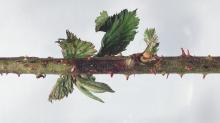See:
Blackberry Cultivar Susceptibility
Cause Septocyta ruborum, a fungus similar to the one that causes septoria leaf spot. Field observations in Oregon have shown 'Marion', 'Evergreen', 'Kotata', and 'Waldo' blackberries are affected. Symptoms will not develop unless a chilling requirement is met. Spores are produced in spring on symptomatic floricanes and infect only primocanes. Conidia are rain dispersed and collect near the base of trichomes before infection. Stomata are the primary infection court; however, deep wounds or cuts are also infected. Experimentally, spores do not seem to infect stems if only the epidermis is scraped away.
Symptoms Dark green, irregularly shaped lesions appear on canes late in the growing season. During winter and spring, lesions become purple with a red margin. Affected areas 0.5 to 2 inches long develop into cankers and girdle canes. Severely affected canes die in spring. Lesions become pale-brown in late spring and small, black, fruiting structures (pycnidia) develop in the lesion's center. Leaf spots do not develop.
Cultural control
- Grow less susceptible cultivars such as Boysenberry or Loganberry.
- The disease has not been a problem in alternate-year (AY) fields when canes are trained up as they grow. If canes are allowed to lie on the ground, the disease can be just as severe as in fields where berries are harvested annually.
- Remove old fruiting canes after harvest.
- Trellis canes in August or early September or in late spring. Canes trained after early September may be more susceptible to winter injury. Wait until February or March. Evergreens are more winter-hardy and usually can be trained safely through the winter.
- Control weeds because they can provide a natural "moist chamber" for infection and prevent effective spray coverage.
- Use plant spacing and canopy management that promotes good air circulation.
- Practice early-season primocane control.
Chemical control Fungicides will not remove the disease once it develops on floricanes. Spray applications help prevent infection on young primocanes. Tank-mix and/or alternate products from different groups with different modes of action to prevent the build-up of resistant fungi. Minimize the use of any one group during the growing season.
- For every-year (EY) producers, spray after harvest.
- Fixed coppers such as Nu-Cop, C-O-C-S, Nordox, Cuprofix, or Kocide most with a 48-hr reentry. Monterey Liqui-Cop or Bonide Copper Fungicide for the home. H O
- Rex Lime Sulfur Solution (28%) at 0.5 to 1.25 gal/100 gal water. 48-hr reentry. O
- Spray again in early October before heavy rains begin.
- Bonide Captan 50 WP at 3 Tbsp/gal water can be used in home gardens - Washington only. Do not use within 3 days of harvest. H
- Bordeaux 8-8-100. O
- Fixed coppers such as Nu-Cop, C-O-C-S, Nordox, Cuprofix, or Kocide most with a 48-hr reentry. O
- Spray again at budbreak in early March.
- Rex Lime Sulfur Solution (28%) at 6 to 12 gal/100 gal water. May burn leaves when shoots are 0.75 inch or longer. 48-hr reentry. O
- Fixed coppers such as Nu-Cop, C-O-C-S, Nordox, Cuprofix, or Kocide most with a 48-hr reentry. Liqui-Cop for the home. H O
- Sulforix at 3 gal/100 gal water. Apply as a delayed dormant spray. 48-hr reentry.
- Spray young primocanes at 0 to 6 inches growth, 12- to 18-inch growth, and 2- to 3-foot growth.
- Bonide Captan 50 WP at 3 Tbsp/gal water can be used in home gardens. Washington only. Do not use within 3 days of harvest. H
- Captan 80 WDG at 2.5 lb/A. Do not apply within 3 days of harvest. Group M4 fungicide. 48-hr reentry.
- Fixed coppers such as Nu-Cop, C-O-C-S, or Kocide. 48-hr reentry. O
- Pristine at 18.5 to 23 oz/A. Do not use with any other tank additive. Can be used day of harvest. Group 7 +11 fungicide. 12-hr reentry.
References Martin, R.R., Ellis, M.A., Williamson, B., and Williams, R.N. 2017. Compendium of Raspberry and Blackberry Diseases and Pests. 2nd edition. St. Paul, MN: APS Press.
Baguant, J, Adair, R.J., and Lawrie, A.C. 2008. Infection process of Septocyta ruborum, a coelomycetous fungus with potential for biological control of European blackberry in Australia. In Proceedings of the 16th Australian Weeds Conference, Cairns Convention Centre, North Queensland, Australia, 18-22 May, pp. 251-253. Queensland Weed Society.



